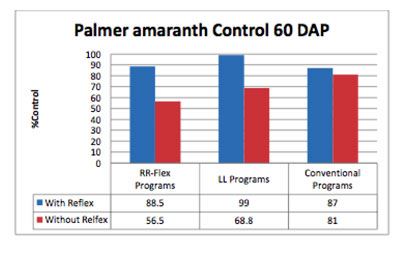Cotton Weed Control
PORTAGEVILLE, MO.
One of the major threats that producers are facing today in the Missouri Bootheel is Palmer amaranth. Palmer has the ability to produce over 500,000 viable seeds, can take over a field in 3-4, and greatly reduce profits. Agriculture has stepped back in time and has reverted back to reliance of chopping or hoe crews to control palmer.
With this issue in mind a study including three programs was set up to evaluate weed control programs in cotton. Roundup ready, liberty link and conventional programs were evaluated for Palmer amaranth control. Weed control programs that included Reflex controlled Palmer at least 86% 60 days after planting. While those that didn’t include Reflex ranged from 55-80%. The Reflex treatments within the study were applied preplant and received an activating rain – which is a crucial component of these residual pesticide applications.

Weed control in Missouri has dramatically changed with the increased populations of glyphosate resistant Palmer amaranth. It’s not going to be easy. Reflex is not the answer, but part of the answer. We need to use multiple modes of action along with crop rotation, trait rotation, and seed bank management to control Palmer amaranth. Populations of glyphosate resistant Johnsongrass have been confirmed in Arkansas. We can only assume that it won’t be long until we will be facing this as well. Δ
DR. JASON WEIRICH: Assistant Professor, University of Missouri
KENT FOTHERGILL: Research Specialist, University of Missouri